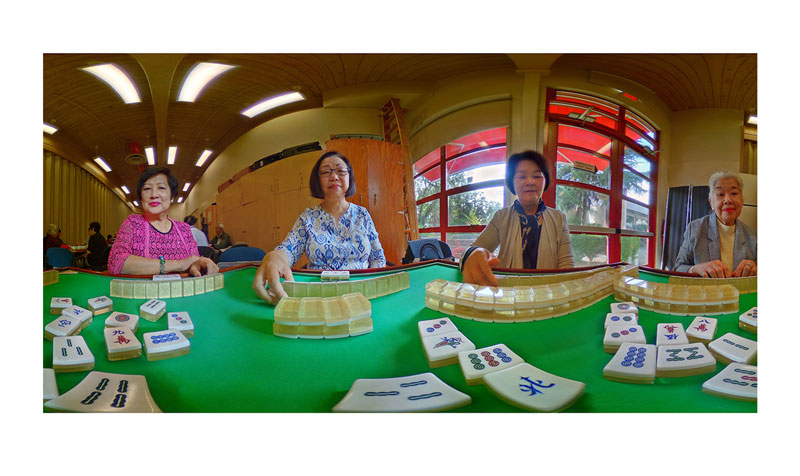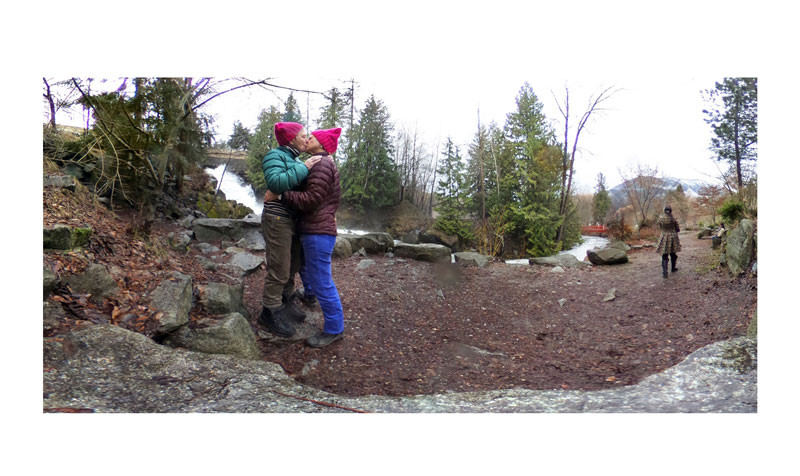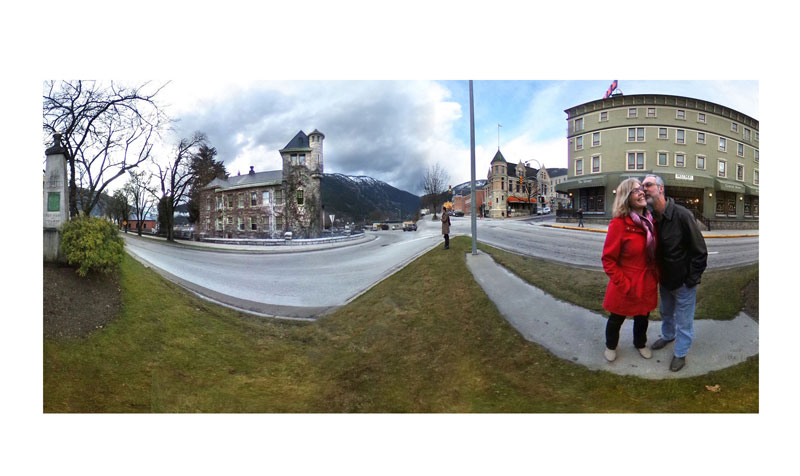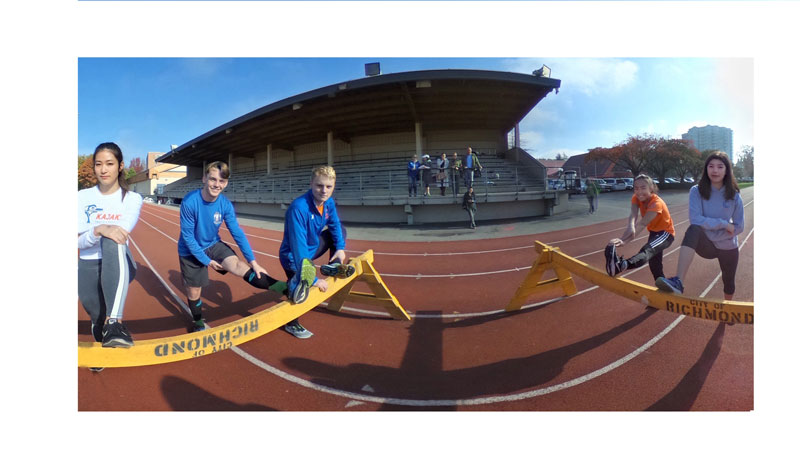G.6 WORKSHOP Learning to Use Meaningful Action Research and Community Engagement to Produce Canadian Art and Histories
Sat Oct 17 / 11:00 – 12:30
voice_chat expiredguest chair / Sylvia Grace Borda, Climate Arts
This Workshop explores contemporary art approaches to urban mapping and the relationship to identity, sustainability, well-being and community connections.
Two Google Street View art projects will initiate discussion among the panelists. The projects are based in two multicultural cities in British Columbia, Canada – the City of Richmond and the City of Nelson. Each city was the site of a public artist-in-residency by presenter (artist), Sylvia Grace Borda, to capture the essence of diversity, community and embracing spirit among those who call each city their home, and a collective response to the changing urban and rural landscape.
Panelists will interact with participants on key themes, challenges and successes drawn from the projects to delve further on engagement in arts practice. A portion of the workshop webinar encourages participants to exchange ideas on using action research to help inform art history +/ creation of contemporary art responding to issues of meaning to them. The workshop concludes with combined learnings on building mindful approaches reflecting shared lived experiences and identity.
Sylvia Grace Borda is an artist, guest academic lecturer (UBC), former MA Convener Media and Art History, Queen’s University Belfast acknowledged for her work addressing the built environment, community and climate engagement through contemporary arts and regenerative practice. She is the founder of C.A.R.E. (Climate Arts for Resilient Environments) and was recipient of the EU-funded “Frontiers in Retreat” arts fellowship (2013-17). As a fellow she developed socially engaged ecological artworks for Helsinki International Arts Programme, Mustarinda Arts (Finland), Serde Arts (Latvia), and Scottish Sculpture Workshop. Sylvia has spoken at the British Council’s ‘Absorbing Modernity’ Venice Biennale roundtable (Northern Ireland), Glasgow’s Lighthouse ‘Recasting Modernism seminar’, and the International Union for the Congress of Nature (UN 2016) about the arts as a conduit to chronicle, reflect and action community and cultural preservation of regional and natural environments. Sylvia is an inaugural C40 Cities recipient (2019-20) of the Women4Climate Change program (City of Vancouver).

Mah Jong players at Minoru Centre from the series What are you doing, Richmond?, 2018, C-41 print 24"x36", Collection of Richmond Public Art Program, Dimensional Google Street View portrait
G.6.1 Joining Space and Time in the Art of Relationship
Edward Bateman, University of Utah
Edward Bateman will address the embedding of contemporary digital artworks within a community partnership and how such participatory action resulted in the strengthening of cultural and community connections. As part of his workshop outcomes, Edward will invite audiences to reconsider how research action can build more robust art histories and artworks.
There is a tendency to think of digital art as a manipulation of information or as a synthetic process of world building. The work of Sylvia Grace Borda, as seen in her Kissing Project (2016-17) and What are you doing, Richmond? (2018), remains indexical reflecting the communities and people she engages with. There is much to discover in Borda’s work that may not be apparent to the casual viewer, including the challenges of their creation involving relationships with place, community individuals, and intergenerational audiences. Formatted in the now pervasive Google Street View, Borda’s work breaks with the Western canon of depiction of a fixed perspective while remaining fully grounded in the history of photography. One can see echoes in her work to much of that history, beginning with the diorama theatre of photography inventor Daguerre and extending through the work of contemporary artists. While the intimacy of kissing in photographs has often implied a sense of place, rarely has it been combined with the genre of the landscape. Most surprising to me is the connection of her work to Chinese scrolls with their ability to engage viewers to explore and discover the connections between people and place. And like any good relationship, that takes time.
Edward Bateman is an artist and professor at the University of Utah. Nazraeli Press released Mechanical Brides of the Uncanny (2009), a limited-edition book of his work which is in the collections of numerous institutions. He has been included in a half dozen textbooks, including Seizing the Light: A Social and Aesthetic History of Photography (2017) where he contributed images and collaborated on its new chapter on digital photography. Bateman has been twice short-listed (2014 & 2016) for the Lumen Prize, described by The Guardian Culture Blog (U.K.) as “The world’s preeminent digital art prize.” Bateman’s work has been exhibited in over twenty-seven countries and is in the collections of the Museum of Fine Arts Houston, The Victoria & Albert Museum, The China Printmaking Museum, and Getty Research Institute, among others. His work was awarded the Nature Prize (2018) at the Royal Geographical Society in London.

Mary Whitlock and Nancy Rosenblum, Cottonwood Falls, from the series The Kissing Project, 2017
G.6.2 Moving Forward and Back in Time – Navigating Art and Diversity in Google Street View
Garnet Dirksen, Photo-Artist
Within the last three years, Sylvia Grace Borda has authored a series of autonomous, community-engaged artworks and portraits in Google Street View, the ubiquitous platform which enables users to view an area from afar. While this quality is something still photography has made possible from its inception, Sylvia has helped forge an altogether new photographic language, shifting contemporary art into the next generation of technology.
Artists are constantly experimenting with new technologies such as Street View, utilizing digital devices and social media in ways their creators had likely not foreseen. However, we still do not fully understand how these rapid changes in artistic practice are re-shaping community engagement and our relationship to Canadian art histories. Sylvia’s work provides us some answers, straddling the divide of analog and digital approaches to art making, while extending the realm of the photographic image. By embracing new technology in her artmaking, and inviting the public to create collaborative works, Sylvia uses the familiar language of Google to forge new possibilities for engagement. Simultaneously, her work fulfills multiple functions as artwork, town showcase, and community archive. Sylvia’s works have become even more relevant this year as traditional galleries, artists and platforms struggle to present work from a distance. Her artworks are reflectors of how we can approach creative practices with communities as a new way to access, engage and experience our Canadian identity. There are also important opportunities to reflect on how these practices can fill the gaps of diversity, social inclusion, and the representation of the rural. Through the use of technology, Sylvia has managed to utilize a medium known for “taking” and shifted it in a more generous direction. In this workshop, the question of generosity is used as a process to understand how to add new terminology to describe art for wider audiences.
Garnet Dirksen is a photographic artist from Merritt, British Columbia. He holds a BFA from Thompson Rivers University (2017) and is completing his MFA in Photography at Concordia University (2020). He has been the recipient of numerous research, academic and artistic grants and awards including an Undergraduate Research Experience Award (2016), an SSHRC Joseph-Armand Bombardier Graduate Scholarship (2018), and the Roloff Beny Foundation Fellowship in Photography (2018). He is currently nominated for the Scotiabank New Generation Photography Award. During his time at Concordia he has served both as a teaching assistant and as a sessional instructor.

Holly and John Strilaeff by the Courthouse, from the series The Kissing Project, 2017, C-41 print, Collection of Touchstones Museum of Art and History, Nelson, BC, Dimensional Google Street View portrait
G.6.3 Reimagining Cultural Heritage: Strengthening Cultural and Community Connections Through Innovative Arts Practices
Arin Fay, Touchstones Museum of Art and History
Touchstones Nelson: Museum of Art and History is uniquely positioned as: museum, archive, gallery, and heritage site to undertake, support and engage with artists, historians and community members by-way-of art/history convergence projects of myriad scope, scale and medium. Art/History convergence projects have been a focus for many years, and have involved a wide-array of medium and method. By reimagining cultural heritage and borrowing from archival photographic imagery, Sylvia Grace Borda’s Kissing Project sought to reimagine the Touchstones' archive collection, community engagement, combined with the use of technology, to produce an accessible and new cultural heritage experience. Similarly Gu Xiong’s The Unknown Remains likewise utilized video and photography, ephemera and immersive community engagement to create meaningful site specific dialog and connection to both regional and global patterns.
In this workshop discussion, Touchstones Nelson Museum of Art and History curator, Arin Fay, will address the embedding of contemporary artwork, ephemera and installation within a community space and zeitgeist, whether it be public, virtual, environmental, et al, and the resulting strengthening of cultural and community connections. Fay will explore the use of art/history convergence work in a cultural heritage context, and how this process itself can potentially lead to innovations in both engagement and legacy co-creation.
Arin Fay is a curator and writer living in the interior of BC. Arin has curated and toured numerous exhibitions regionally, including Marianne Nicolson’s Waterline and Toru Fujibayashi and Tsuneko Kokubo’s Regeneration, and is currently touring the Paul Seesequasis Turning the Lens archival photo project across Canada. Arin has had the privilege to work with outstanding artists from across Canada (Heather Benning, Amanda Strong, Paul Seesequasis, Sonny Assu, Brendan Tang, Brenda Draney, Gu Xiong, et al). Fay attended the Banff Centre – Writing with Style Program & Truth and Reconciliation through Right Relations Leadership Intensive, as well as residencies at Mackenzie Art Gallery and Sled Island. Fay has been an active member of the arts and culture community in the Kootenays for over twenty years, as an artist, volunteer, board member and curator. Fay is currently the Curator at Touchstones Nelson Museum of Art and History in Nelson, British Columbia.

Kajak Youth track and field runners at Minoru Park, from the series What are you doing, Richmond?, 2018, C-41 print 24"x36", Collection of Richmond Public Art Program, Dimensional Google Street View portrait
G.6.4 How to Make Art with Others: Slow Curating & the Spectra of Engagement
Megan Arney Johnston, Concordia University St. Paul (Minneapolis), Century College
As an idea ‘Slow’ is not about time per se, but about connection. If we understand the Slow Movement as one that addresses the issue of “time poverty” through making connections, then how might we utilize slowness in our approaches to art? While taking time is an important part of this movement, we should be focusing on the significance of human connection through slow creativity. There is an urgent need to creatively address conflict, division, hate, and our disembodied world. Speaker Megan Arney Johnston, Independent Curator, will showcase how decidedly slow practices take shape through intentional interventions and exchanges, developing creative strategies to foster human connections. By using examples from Sylvia Grace Borda’s artworks and Slow Curating practice, Johnston will address how socially engaged work provides a framework for working within and with various and diverse audiences. She will discuss how the idea of “slow” practices can be utilised for more relevant community experiences. In particular, Slow Curating is a reflective framework embracing polyvocality, human connection, and place-based, contextual exhibition-making. As a social practice, it aims to disrupt and re-imagine curatorial roles, exhibition production, knowledge, memory, and processes of mediation – from project inception to presentation. Authorships, expertise, objects, knowledge and engagement are intentionally complicated.
In this workshop, Johnston will draw on aspects of Slow Curating as an intentional process of collaboration, context, and engaging within communities. Through the presentation of her Slow Curating framework (research + experiment + observation + reflection + dialogue + alteration + repeat), Johnston will, for the first time publicly, discuss the definitions of social practice – as a Spectra of Engagement.
Megan Arney Johnston is an independent curator, museum specialist, and educator who utilizes socially engaged curatorial practices centering on fundamental questions about art, its display and mediation. She coined the term Slow Curating in 2011. Megan has a BA in History of Art, focusing on Contemporary art and French Realism (with Dr Gabriel Weisberg) and minor in Women’s Studies and Feminist Art (with Griselda Pollock). Megan broke new academic ground in post-conflict and art research with her MA in Irish Visual Culture (University of Ulster, Belfast) focusing on visual manifestations of the construction of ‘Orange’ culture, a show recognized as a benchmark for the utilization of art and conflict resolution. She will receive her PhD in Museology and Curatorial Practice (UU, 2020). Megan has curated more than 300 exhibitions in Europe and the U.S.A., has written extensively and presented on social practice at international conferences.



